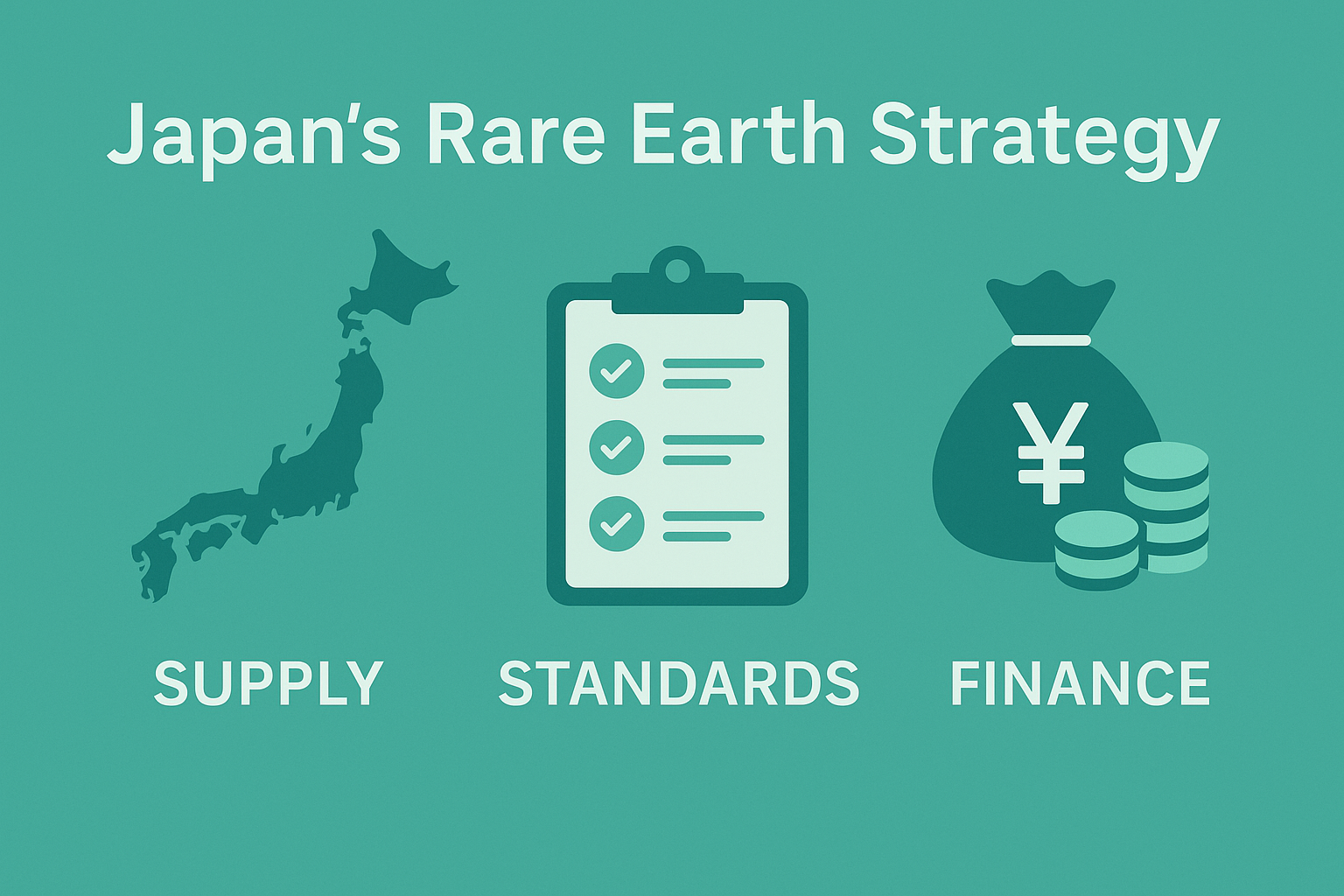— Analytical Report by a Senior Economic Strategist —
- Executive Summary
- Ⅰ. Japan’s Vulnerability Assessment
- Ⅱ. National Strategy Framework — Five Pillars
- Ⅲ. Policy Levers and Responsible Agencies
- Ⅳ. International Strategy
- Ⅴ. Sectoral Impact Matrix
- Ⅵ. Quantitative Roadmap (KPIs)
- Ⅶ. Scenario Planning (12–36 Months)
- Ⅷ. Financial Architecture (Illustrative Case)
- Ⅸ. Corporate Action Checklist
- Conclusion
Executive Summary
Japan’s sustainable security in the era of resource weaponization requires a triangular strategy:
Supply (diversification) × Standards (design & substitution) × Finance (stabilization & leverage).
- Supply – Build a three-tiered system: friend-shoring, domestic midstream capability (separation → metal → magnet), and recycling, reducing dependence on China from 50% → 30% → 20% over five years.
- Standards – Redesign industrial specifications for dual sourcing (A/B magnet standards) and modular substitution to prevent single choke points.
- Finance – Deploy blended funding via JOGMEC–JBIC–NEXI to stabilize prices, guarantee offtakes, and hedge the “investment valley” risk with a state-backed price floor.
Ⅰ. Japan’s Vulnerability Assessment
| Weakness | Description |
|---|---|
| Midstream gap | Japan excels in advanced materials but lacks sufficient domestic refining, metalizing, and alloying capacity. |
| Single-source dependency | Automotive and heavy-electrical industries rely heavily on specific magnet grades from Chinese suppliers. |
| Cyclical investment trap | When prices drop, investment halts; when shortages occur, dependency surges again — a structural “resource cycle trap.” |
| Human & technical deficit | Skilled engineers for solvent extraction, ion adsorption, and green processing are in short supply. |
Ⅱ. National Strategy Framework — Five Pillars
Pillar A: Supply Diversification (Friend-shoring + Domestic Production)
- Friend-shoring with Australia, Canada, Vietnam, India, and South Africa through integrated mine-to-separation investments.
- Domestic midstream expansion across three regional clusters (East–Central–Kyushu) for redundancy and resilience.
- Strategic reserves for NdPr, Dy, and Tb by application category (EVs, defense, energy).
Pillar B: Standards and Design Flexibility
- Introduce A/B dual standards for motors and generators to enable rapid supplier switching.
- Promote low-rare-earth and magnetless motor designs (e.g., Switched Reluctance or Axial Flux architectures).
- Embed multi-sourcing standards in public procurement and defense programs.
Pillar C: Price Stabilization and Market Function
- Establish a national price floor and long-term offtake contracts via JOGMEC to mitigate volatility.
- Create inventory finance systems using warehouse receipts and NEXI-backed repo facilities for traders.
- Support environmental CAPEX for green refining under ESG-linked incentives.
Pillar D: Recycling and “Urban Mining” Industrialization
- Standardize processes from collection → separation → remagnetization with national KPIs (+15 pts recovery rate in 3 years).
- Reform negative-cost recycling through reverse rebate mechanisms between OEMs and recyclers.
- Build cross-border E-waste recovery networks within ASEAN for resource circulation under Japanese certification.
Pillar E: Human Capital and Intellectual Property
- Launch graduate programs specializing in rare-earth chemical engineering and materials processing (target: +200 engineers/year).
- Secure Standard-Essential Patents (SEPs) for new separation solvents and micro-Dy diffusion technologies.
- Concentrate R&D and pilot facilities in existing material clusters (Tohoku, Tokai, Kyushu).
Ⅲ. Policy Levers and Responsible Agencies
| Policy Lever | Implementation | Lead Actors |
|---|---|---|
| Blended Finance | JOGMEC equity + JBIC long-term debt + NEXI insurance + private mezzanine | METI / JOGMEC / JBIC / NEXI |
| Price Floor & Offtake | NdPr floor + Take-or-Pay contracts with OEMs | METI / JOGMEC / auto & heavy industries |
| Standardization | Dual certification fast-track hub | METI / JIS / industry consortia |
| Stockpiling | Category-based reserves (EV, defense, energy) | Cabinet Office / METI / Trading houses |
| Human Capital | Graduate & technical “Rare Earth Track” programs | MEXT / METI / academia |
| Recycling Framework | Reverse rebate + cross-border recovery rules | METI / MOE / Local governments |
Ⅳ. International Strategy
- Deepen MSP/QUAD cooperation via Japan-led Special Purpose Vehicles (SPVs) combining mine and separation projects with offtake-linked DSCR structures.
- EU alignment: mutual recognition under the Critical Raw Materials Act (CRMA) to treat Japanese midstream capacity as “quasi-domestic” for EU sourcing ratios.
- ODA & governance diplomacy: combine yen loans and technical assistance for partner nations’ resource governance, inspection, and training systems.
Ⅴ. Sectoral Impact Matrix
| Sector | Primary Risk | Immediate Countermeasure | Mid-Term Reform |
|---|---|---|---|
| Automotive (EV) | NdPr/Dy dependence | Dual A/B magnet standards, dual offtake | Magnetless/low-RE designs, in-house magnet lines |
| Heavy Electrical / Wind | Supply wave in large magnets | Long-term contract + stockpile KPI | Domestic alloy-to-magnet chain |
| Precision Instruments | Trace additive shortages | Parallel certification of substitutes | Stable supply from recycled sources |
| Defense | Prioritization opacity | Dedicated reserve ring | Redundant domestic production line |
Ⅵ. Quantitative Roadmap (KPIs)
| Metric | Target |
|---|---|
| China dependency | 50% → 30% (2 years) → 20% (5 years) |
| Domestic separation capacity | +6–8k tons NdPr equivalent/year |
| Magnet output | +30–40k tons/year |
| Recycling recovery rate | +15 pts in 3 years |
| Recycled content in products | ≥15% blended ratio |
| Skilled workforce | +1,000 engineers in 5 years |
| Strategic stockpile | 90–120 days of supply by category |
Ⅶ. Scenario Planning (12–36 Months)
Scenario 1 – Managed Detente (30–35%)
- Approach: Stabilize through flexible import approvals; rely on multi-offtake + stockpile KPIs.
- Actions: Pilot price floor, accelerate domestic midstream subsidy, create fast-track certification desks.
Scenario 2 – Gradual Escalation (40%, Base Case)
- Approach: Expand price floors and activate state reserves; accelerate alliance project funding.
- Actions: JBIC bridge loans to SPVs, explicit defense priority allocation framework, DoD–METI coordination.
Scenario 3 – Shock Embargo (15%)
- Approach: Immediate release of reserves and military-civil prioritization.
- Actions: Temporary tariff and transport subsidies, rapid alternative-material certification.
Scenario 4 – Structural Dual-System (10%)
- Approach: Institutionalize dual supply chains and standards (“Tech Bloc Economy”).
- Actions: Global standardization diplomacy to embed Japanese specifications as international SEPs.
Ⅷ. Financial Architecture (Illustrative Case)
Project: Australia–Japan dual-node REE chain (separation → metalizing)
- Equity: JOGMEC 15% (subordinated), trading & material firms 35%, local partner 50%
- Debt: JBIC senior loan (long-term fixed), commercial co-lenders, NEXI political risk cover
- Contract: 10-year Take-or-Pay with Japanese OEMs + price floor clause
- Risk Allocation: Government absorbs price risk; companies hedge volume via stockpiles and finance facilities
- IRR Enhancers: Accelerated depreciation, investment tax credit, ESG subsidy for green refining
Ⅸ. Corporate Action Checklist
- Design: Implement dual-certified magnet specifications with alternative material pathways.
- Contracts: Integrate dual offtake + price floor clauses and clear force majeure allocation.
- Inventory: Maintain 90–120 days safety stock, utilize NEXI-backed repo financing.
- Information: Build real-time dashboards tracking customs lead times, license delays, and shipping ETAs.
- Talent: Establish rotational programs combining chemical, material, and equipment expertise.
Conclusion
Japan’s future in the rare earth era depends on Supply diversification, Standard resilience, and Financial cushioning — the SSF Triad.
The nation must transition from being a beneficiary of global supply chains to becoming their architect and stabilizer.
“From efficiency to resilience, from dependence to design — this is Japan’s next industrial mandate.”


